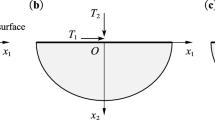Abstract
The general equations for crack-tip stress fields in anisotropic bodies are derived making use of a complex variable approach. The stress-intensity-factors, which permit concise representation of the conditions for crack extension, are defined and are evaluated directly from stress functions. Some individual boundary value problem solutions are given in closed form and discussed with reference to their companion solutions for isotropic bodies.
It is found that an elastic stress singularity of the order r −1/2 is always present at the crack tip in a body with rectilinear anisotropy (r being the radial distance from the crack front). This result and some additional consideration of the crack-tip stress fields imply that it is possible to extend current fracture mechanics methods to the representation of fracture conditions for anisotropic bodies with cracklike imperfections.
Résumé
On dérive l'Equation générale des champs de tension d'une pointe de fissure dans un corps anisotrope par une approximation de variable complexe. On a dévini et évalué les facteurs d' intensité de tension qui permettent la représentation concise des conditions pour l'extension d'une fissure, directement des fonctions de tension. On donne quelques solutions de problèmes à valeur limite en forme implicite et on les discute en correspondance avec les solutions analogues pour corps isotropes.
On a trouvé qu'une singularité de tension élastique de l'ordre de r −1/2 (où r est la distance radiale depuis le front de la fissure) est toujours présente à la pointe d'une fissure dans un corps rectilinéairement anisotrope. Ce résultat et quelques considérations additionelles des champs de tension de la pointe d' une fissure impliquent la possibilité d'étendre les applications courantes de théories de mécanisme de fracture à la représentation de conditions de fracture de corps anisotropes avec des imperfections en forme de fissures.
Zusammenfassung
Die aligemeinen Gleichungen für Spannungsfelder an der Spitze eines Risses in anisotropischen Körpern werden näherungsweise unter Benützung einer komplexen Variabele abgeleitet. Die Spannungsintensitätsfaktoren, die eine kurzgefasste Darstellung der Bedingungen für Rissausbreitung gestatten, werden definiert and unmittelbar aus Spannungsfunktionen bestimmt. Einige individuellen Lösungen von Grenzwert-Problemen werden in geschlossener Form gegeben and bezüglich ihrer analogen Lösungen für isotrope Körper diskutiert.
Es ergibt sick, dass eine elastische Spannungssingularität der Ordnung r −1/2 an der Spitze eines Risses in einem Körper mit rectilinearischer Anisotropie immer da ist. (r ist die Radiusabstand von der Rissfront). Dieses Ergebnis, und einige weiteren Betrachtungen der Spannungsfelder an der Rissspitze weisen darauf hin, dass es möglich ist, die geläufigen Methoden der Bruchmechanik für die Darstellung von Bruchbedingungen anisotropischer Körper mit rissartigen Fehlern zu erweitern.
Similar content being viewed by others
References
G.R.Irwin Handbuch der Physik, 6, Springer-Verlag, Berlin, 1958, pp.551–590.
G.C.Sih, P.C.Paris, and F.Erdogan Trans. ASME, J. Appl. Mech., 29, 2, June 1962, pp.306–312.
G.C.Sih Trans.ASIv1E, J. Appl. Mech., 32, 1, March 1965, pp.51–58.
J.J. Gilman Fracture, Technology Press and John Wiley and Sons, 1959, pp. 193–224.
C. Zener Elasticity and Anelasticity of Metals, University of Chicago Press, 1948 pp. 7–23.
L. N. G.Filon Proc. Roy. Soc. (London), Series A, 160, 1931, pp.137–154.
S.G.Lekhnitskii Theory of Elasticity of an Anisotropic Body, Chapter 3, Holden-Day, Inc., 1963.
R.L.Chapkis and M.L. Williams Proc. of Third U.S.Natl.Congr.Appl.Mech., 1958, pp.281–286.
G.N.Savin Stress Concentration Around Holes, Chapter 3, Pergamon Press, 1961.
L. M.Milne-Thompson Plane Elastic Systems, Chapter 7, Springer-Verlag, Berlin, 1960.
T.J.Willmore Quar. J. Mech. Appl. Math., 2, 1, 1949, pp.53–63.
G.I.Barenblatt and G. P.Cherepanov PMM (Translated by ASME), 25, 1, 1961, pp. 61–74.
D.D.Ang and M.L.Williams Trans. ASME, J. Appl. Mech., 28, 3, September 1961, pp.372–378.
A.E.Green and W.Zerna Theoretical Elasticity, Oxford at the Clarendon Press, 1954, pp.324–374.
N.I.Muskhelishvili Some Basic Problems of Mathematical Theory of Elasticity, Chapters 15 and 18, P.Noordhoff and Co., 1953.
Author information
Authors and Affiliations
Rights and permissions
About this article
Cite this article
Sih, G.C., Paris, P.C. & Irwin, G.R. On cracks in rectilinearly anisotropic bodies. Int J Fract 1, 189–203 (1965). https://doi.org/10.1007/BF00186854
Received:
Issue Date:
DOI: https://doi.org/10.1007/BF00186854




